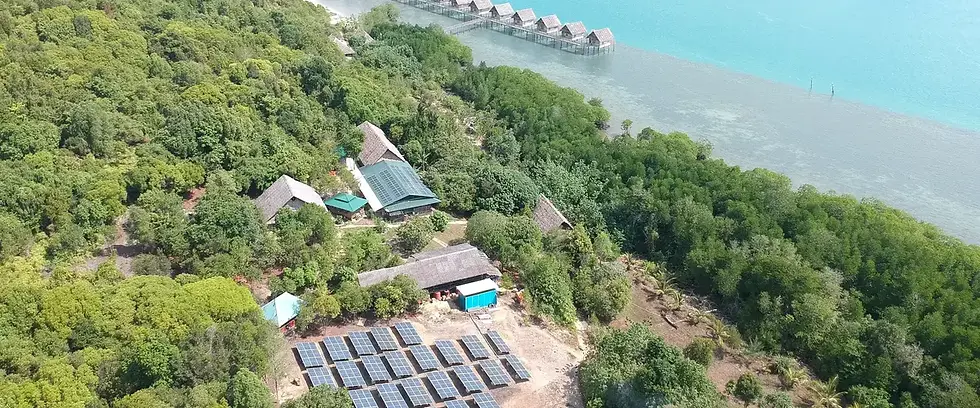Canopy Power: While the U.S. Debates Grid Resilience, a Singaporean Startup Is Powering Remote Community
- Yuhang Song
- Apr 6
- 4 min read
Updated: Oct 28
By Greennex Frontier

For decades, the U.S. power system has faced three persistent structural challenges:
• Vulnerability of centralized grids: Extreme weather has led to frequent large-scale blackouts in California, Texas, and Puerto Rico.
• Uneven infrastructure distribution: Rural, tribal, and off-grid communities remain underserved by clean energy access.
• Deployment barriers for microgrids: Despite increasing policy support, projects often struggle with high upfront costs, fragmented technologies, and lack of scalable delivery models.
While U.S. federal and state governments continue investing heavily in smart grids, transmission, and storage, there are still few proven models for deploying localized, resilient, low-emission energy systems. In Southeast Asia, however, one Singapore-based company is quietly building such a model — from the edges in.
Canopy Power: A Systems Integrator for Remote Renewable Microgrids
Founded in 2016, Canopy Power designs and delivers renewable microgrid systems for off-grid islands, industrial estates, eco-resorts, and agricultural sites. Its core offering integrates solar PV, battery storage, diesel backup, and intelligent energy management into self-sustaining microgrids.
The company’s business structure is “end-to-end,” with three core services:
1. Project Development & Financing Advisory
Helps clients model projects and access financing through Energy-as-a-Service (EaaS) or off-balance-sheet structures.
2. Engineering, Procurement, and Construction (EPC)
Designs and delivers tailored systems based on site-specific loads and constraints, with an emphasis on reliability and redundancy.
3. Operations, Maintenance, and Digital Monitoring
Through its proprietary Hornbill platform, Canopy Power offers remote diagnostics, energy analytics, and predictive maintenance to ensure long-term system performance.
Founder Profile: A Systems Thinker with an Engineering Core
Canopy Power CEO and founder Sujay Malve is a former Shell executive with an engineering and business background. His founding motivation was shaped by on-the-ground exposure to energy inequality in Southeast Asia:
“When you see island communities paying four times more for diesel power, suffering blackouts daily, and kids studying in the dark — you realize this isn’t a technology issue. It’s a systems failure.”
Rather than framing Canopy Power as an EPC firm, Malve set out to productize the design-finance-operate stack — enabling scalable deployment of off-grid infrastructure with built-in service continuity.
“Electricity shouldn’t be rationed. It should be an enabler.”
Partnership Model: Scaling Through Financial and Technical Alliances
Canopy Power’s expansion across Southeast Asia is anchored in a network of partnerships:
• Total Carbon Neutrality Ventures (2021)
An investment from TotalEnergies’ venture arm supported Canopy’s hybrid microgrid deployment in Indonesia and the Philippines.
• Ocean Sun (2025)
A collaboration with Norway-based Ocean Sun brought floating solar technology to the Australian market — addressing land scarcity and water stress with dual-use infrastructure.
• SUSI Partners Asia Energy Transition Fund
Backs Canopy Power’s solar + storage projects across Southeast Asia’s off-grid markets, providing long-term capital.
These partnerships have enabled Canopy Power to standardize its technical delivery while modularizing its financing — reducing per-project cost and time-to-deploy.
Valuation and Business Model: Grounded in Peer-Based Inference
Canopy Power has not disclosed valuation figures or detailed financials. However, peer benchmarks offer insights into its likely revenue structure and market position.
Revenue Model
Canopy Power likely draws income from three channels:
1. EPC Revenue (one-off)
Income from system design and installation, with typical gross margins of 15–25% depending on geography and procurement scale.
2. Energy-as-a-Service (EaaS)
In cases where Canopy retains system ownership, clients pay for electricity use under long-term service agreements. This creates recurring revenue with stable cash flow and attractive IRRs.
3. Remote O&M and Data Services
Hornbill, the proprietary platform, supports predictive maintenance, remote monitoring, and optimization — generating high-margin SaaS-style income with retention potential.
Clients typically operate under 7–15 year contracts, with further upsell opportunities via system upgrades, expansions, or energy performance services.
Valuation Logic
Using industry benchmarks:
• Commercial microgrids are valued at $2–5 million per MW installed.
• Platform-style operators (with recurring O&M or EaaS income) are valued at 4–6x forward revenue.
Given its project footprint, partnerships, and service integration, Canopy Power is likely in the $30–60 million valuation range, according to multiple Asia-based infrastructure investors. Should its floating solar or digital operations gain scale, that valuation ceiling could shift upward.
Why the U.S. Should Take Note: Fixing the Missing Execution Layer
Canopy Power’s model offers three clear takeaways for U.S. clean energy stakeholders:
1. Standardization reduces microgrid deployment friction
By combining modular design and digital O&M, Canopy creates replicable, lower-cost systems — a missing ingredient in many U.S. pilot programs.
2. Adaptable for high-risk, underserved regions
The model is well-suited to fire-prone California zones, hurricane-affected Puerto Rico, and tribal or rural lands with limited grid coverage.
3. Provides an integrated “delivery layer” for energy equity efforts
Rather than single-point solar or storage grants, Canopy’s stack offers a full deployment framework — including finance, install, and service.
Final Word: A Systemic Rebuild for Decentralized Energy
Canopy Power is not attempting to replace utilities — but it is building something complementary and critically needed. By integrating hardware, finance, digital services, and long-term O&M, it redefines what a microgrid provider can be.
As the U.S. and other regions seek energy systems that are clean, resilient, and equitable, Canopy Power offers a working template — one already proven across diverse geographies.
In a world where power increasingly needs to be local, autonomous, and intelligent, Canopy Power’s microgrids don’t just deliver energy — they deliver agency.bout systems that know how to use them.
Comments